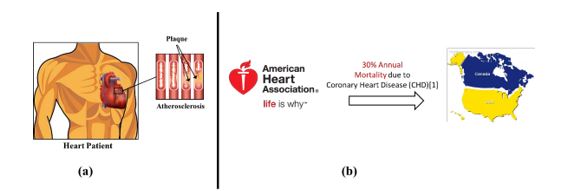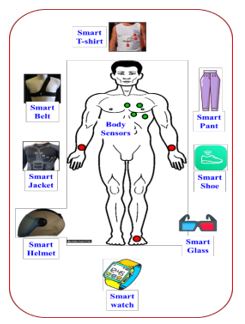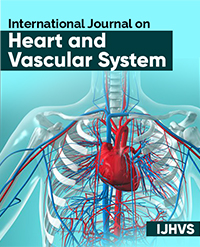Wearable Internet of Cardiac Health (IoCH) Monitoring: The need of the Hour
Hiren Kumar Thakkar*
Department of Computer Science and Engineering, SRM University, India
*Corresponding author: Hiren Kumar Thakkar, Department of Computer Science and Engineering, School of Engineering and Sciences, SRM University, Andhra Pradesh, India
Article History
Received: June 14 2021 Accepted: July 22, 2021 Published: July 23, 2021
Citation: Thakkar HK. Wearable Internet of Cardiac Health (IoCH) Monitoring: The need of the Hour. Int J. Hert & Vasclr Syst. 2021;2(1):04‒06. DOI: 10.51626/ijhvs.2021.01.00002
Abstract
In the recent years, the advancements in the wearable sensor technology has made it possible to apply sensor embedded IoT devices such as smart watch, smart glass, smart phone, and smart helmet to monitor the vital cardiac health parameters. The sensor embedded IoT devices collects the healthcare data in a continuous fashion, which are least useful if not stored, processed, and analyzed in a real-time. Moreover, mearly real-time processing of the healthcare data may not serve the purpose as the underlying data might be highly unstructured and messy. Therefore, Artificial Intelligent (AI) assisted analytical models are required to analyze the healthcare data for cardiac early warning prediction. In this paper, we provide a narrative mini review on the recent advancement in wearable technology is discussed. The paper describes the growin problem of Coronary Heart Diseases (CHDs) and the wearable devices that assist in the acquisition of healthcare data.
Keywords: Gas Wearble devices; Internet of Cardiac Health (IoCH); Artificial Intelligence (AI), Cardiac data, Electrocardiogram (ECG), Seismocardiogram (SCG), Body Area Network (BAN)
Introduction
In the past few years, the life-style of an average individual has changed drastically from the active to sedentary due to technologies, which offer several services from the comfort of being at home and offices. Moreover, the prolonged office hours, irregular sleeping patterns, and unhealthy food habits, have incurred an extra burden on the cardiac health leading to increase in Coronary Heart Disease (CHD) cases. As shown in Figure 1a, the gradual accumulation of plaque in the coronary arteries obstruct the smooth flow of the blood, which causes mild to severe chest pain. According to literature [1], the CHD is a one of the top leading causes of the death in the globe. The data analysis of the American Heart Association (AHA) reveals that the USA and Canada records nearly 30% annual mortality due to the CHD as shown in Figure 1b. The CHD reduces the supply of oxygen-rich blood to the heart and causes severe strain in the heart muscles leading to irregularities in the cardiac functioning. Cardiac cycles are comprised of predefined and well-known sequence of cardiac events between heartbeats. Increasing number of cardiac abnormalities in the cardiac events results in high mortality rate [2].
In the current situation of the high mortality due to the CHDs, it is recommended to monitor the cardiac health at regular intervals. Several health monitoring models are designed using the Artificial Intelligence techniques and its alternatives such as Machine Learning techniques [3,4]. The recent state-of-the-art technologies to monitor and subsequently detect the cardiac abnormalities include Electrocardiogram (ECG), Echocardiography, Computerized Tomography (CT) scan, Magnetic Resonance Imaging (MRI), and nuclear myocardial perfusion scan [5,6] as shown in Figure 2. Usually, the golden standard to monitor the cardiac events is to employ the Electrocardiogram (ECG) technology, which is inexpensive, well researched, and easily available even in the remote areas of developing countries. However, ECG is not suitable and unreliable to monitor the cardiac events as it merely presents five feature points such as “P”, “Q”, “R”, “S”, and “T”, which do not provide detailed cardiac events [7,8]. One of the foremost limitations of ECG is its inability to capture the mechanical vibrations induced by various cardiac events such as opening and closing of heart valves, blood flow in vessels and contraction-relaxation of ventricular walls. On the contrary, Echocardiography is considered a robust, reliable and least invasive alternative to identify cardiac morphology, functioning and hemodynamics. However, Echo is a costly, time taking and it requires a domain expects, which make it infeasible for the long term continuous monitoring. Therefore, for the long term continuous monitoring, wearable devices are extensively used [9,10].
In the past few years, due to the advancements in embedded system design, wearable devices are employed to acquire vital physio and biological signs such as Oxygent level, body temperature, heart rate, blood pressure, respiration rate, Micro vibrations, and ECG etc [11,12]. Figure 3 shows the different types of wearable devices commonly available in the open market used for monitoring and acquisition of the vital physiological signals. The acquired physiological vital signas help the early detection of various diseases via real-time continuous health monitoring. It is observed that such wearable devices are highly flexible, comfortable, portable, and offers acceptable accuracy to be considered for the continuous health monitoring purpose. Continuous monitoring, processing, and analysis of cardiac healthcare data acquired via such wearable devices offers an opportunity of an enhanced diagnostic at reduced cost by acquiring intermittent malfunctioning of various cardiac events. The wearable smart garment is one of the several available wearable devices used to acquire vital health parameters [13]. The Electrocardiogram/Seismocardiogram signals continuously generated by such wearable smart garments are huge in size which needs quick statistical analyses to infer possible CHD problems to generate early warnings to users. Several statistical tools and measures are available that make it is possible to quickly analyze the continuous data by considering signal specific fiducial points such as “P”, “Q”, “R”, “S”, and “T” in ECG. There were various efforts in the literature to engage the robust statistical methods to analyze the ECG signals. However, it is observed that most such statistical methods have limitation to quickly analyse the data and generate the early.
Wearable mHealth Model
The health monitoring is an important aspect to minimize the risk of a sudden illness. However, there is no generalized model in a healthcare that fits to each individual. Therefore, customization and personalization of healthcare monitoring and potential treatment needs to be decided. The data acquired through wearables are of great important as it allows to design an efficient health monitoring model to assist the person to take the precautionary measures. The customization and personalized models help to make the targeted treatment plans that best fit the person’s current health condition. However, exposing the healthcare data to the third party such as insurance companies may negatively affect the individual. For instance, the insurance company may keep tracking the health condition of an individual and determine the potential risk involved based on the lifestyle habits and other vital parameters using machine learning analysis [14]. In such cases, Insurance company may enforce the higher premium on yearly basis and sometimes reject the claim of a person of medical reimbursement. This scenario has advantages also as the insurer will adopt the healthier lifestyle in the long run, which will help reduce the burden on the healthcare budget of the country. The primary advantage of a wearble smartwatch is its convenience.
A typical smartwatch may supply diversified information of various health events in addition to measuring the oxygen level, temperature, pulse rate, etc. It is possible to employ such devices on a large- scale across the various age-group, which collect healthcare big data in a regular interval paving a way to design and develop feasible smart healthcare model, which can analyze the healthcare data of individual and provide the timely diagnosis. If these kinds of devices gathered more and more data, medicare’s feasibility to develop a prevention-based prototype would increase, which can interpret the patient’s data and alert patients for timely diagnosis.
There are different types of wearables in the market [15] as shown in Figure 2. Some of them are mentioned below:
• Smart Watches [9]: The smart watches assist to keep track of time and notifies an individual for important phone calls, text messages, and reminders. Additionally, smart watches also help monitor the body temperature, pulse rate, and oxygen level.
• Smart Glass [8]: The smart glass help logging the events, activity tracking, GPS navigation, in addition to notifying the users about personal messages and phone calls.
• Smart Helmet: The smart helmet embedded with sensors helps continuous monitoring of ECG and SCG signals without disrupting the activities of daily livings.
• Fitness Tracker: The fitness tracker is one of the important wearble devices, which help monitoring the health of the user and logs the daily fitness activities such as step counts etc.
• Head-Mounted Display: The head mount display provides the diversified information to the user by means of creating the augmented reality and virtual reality world.
• Sports Watches: The sports watches are different from smart watches and are specifically designed for the fitness freaks and sportspersons such as the motorist, cyclist, runner, swimmers etc. A GPS tracker is connected to that, which helps record information of the user’s pace, heart rate, calories burnt, etc. [5].
• Smart Jewelry [16]: Few of the smart watches are designed to make it lucarative in the form of the smart jewelry, which potentially open the market for smart watches beyond the fitness freaks.
• Smart Clothing: The wearable devices without comfort do not become commercially successful and therefore they are carefully designed to be embedded in a clothes such as smart jacket, smart belts etc.
• Implantable: These devices are implanted under the skin of the patient. They help in tracking contraception, insulin level, etc.
• Smart Belt: The smart belts are easy to wear and comfortable inner cloth that help capture the cardiac wibrations and other vital singals for continuous health monitoring.
In addition to the sensors used in wearable devices to monitor vital health care data, sensor technology advancements greatly influence the diversified domains such as Wireless Sensors Networks (WSNs) [6,7]. Usually, the sensor acquired data are meaningless unless processed and analyzed using intelligent techniques. Several machine learning-assisted techniques can effectively help analyze Healthcare and data acquired for diversified domains. For instance, in [5], the Seismocardiogram (SCG) data are analyzed for automatic annotation using Machine Learning (ML) assisted binary classification. Similarly, robust Artificial Intelligence (AI) techniques such as Reinforcement Learning (RL) can help analyzed Health care data in a cloud of useful resource utilization [17]. Moreover, ML tools can also be used for predicting
clinically significant motor function improvements [3].
Figure 1: Coronary heart disease and statistics.
Figure 2: Wearable mHealth model.
Conclusion
In this paper, we have described the growing problem of CHDs across the globe, which needs urgent attention. We have emphasized the need for the continuous monitoring of an individual to keep the track of cardiac abnormalities, which accumulate over the period of time resulting into serious cardiac health problem. Moreover, we have pointed out that it is infeasible to monitor the cardiac event in a continuous manner using the existing conventional technologies such as Echocardiography, CT scan, MRI scan etc. and there is a need of alternative low-cost technology that help monitor the cardiac events of an individual without affecting the activities of daily livings. In this regard, we have described the wearable technology and the corresponding wearble devices that assist in the acquisition of the cardiac healthcare data. In future, we will take this work forward to describe the various healthcare data processing and analysis model that help predict the cardiac early warnings.
References
- Yu C, Moore BM, Kotchetkova I, Cordina RL, Celermajer DS (2018) Causes of death in a contemporary adult congenital heart disease cohort. Heart 104(20): 1678-1682.
- Benjamin EJ, Blaha MJ, Chiuve SE, Cushman M, Das SR, et al. (2017) Heart disease and stroke statistics—2017 update: a report from the American Heart Association. circulation 135(10): e146-e603.
- Thakkar HK, Liao WW, Wu CY, Hsieh YW, Lee TH (2020) Predicting clinically significant motor function improvement after contemporary task-oriented interventions using machine learning approaches. Journal of NeuroEngineering and Rehabilitation 17(1): 1-10.
- Hijazi S, Page A, Kantarci B, Soyata T (2016) Machine learning in cardiac health monitoring and decision support. Computer 49(11): 38-48.
- Thakkar HK, Sahoo PK (2019) Towards automatic and fast annotation of seismocardiogram signals using machine learning. IEEE Sensors Journal 20(5): 2578-2589.
- Lin WY, Chou WC, Chang PC, Chou CC, Wen MS, et al. (2016) Identification of location specific feature points in a cardiac cycle using a novel seismocardiogram spectrum system. IEEE journal of biomedical and health informatics 22(2): 442-449.
- Bae TW, Kwon KK (2021) ECG PQRST complex detector and heart rate variability analysis using temporal characteristics of fiducial points. Biomedical Signal Processing and Control 66: 102291.
- Sahoo PK, Thakkar HK, Lin WY, Chang PC, Lee MY (2018) On the design of an efficient cardiac health monitoring system through combined analysis of ECG and SCG signals. Sensors 18(2): 379.
- Sahoo PK, Thakkar HK, Lee MY (2017) A cardiac early warning system with multi- channel SCG and ECG monitoring for mobile health. Sensors 17(4): 711.
- Dunn J, Runge R, Snyder M (2018) Wearables and the medical revolution. Personalized medicine 15(5): 429-448.
- Rai D, Thakkar HK, Singh D, Bathala HV. Machine Learning Assisted Automatic Annotation of Isovolumic Movement and Aortic Valve Closure using Seismocardiogram Signals. In 2020 IEEE 17th India Council International Conference (INDICON); 2020: 1-6.
- Rai D, Thakkar HK, Rajput SS (2020) Performance Characterization of Binary Classifiers for Automatic Annotation of Aortic Valve Opening in Seismocardiogram Signals. In 2020 9th International Conference on Bioinformatics and Biomedical Science; 2020: 77-82.
- Wong WY, Wong MS (2008) Smart garment for trunk posture monitoring: A preliminary study. Scoliosis 3(1): 1-9.
- Thakkar HK, Shukla H, Patil S. A Comparative Analysis of Machine Learning Classifiers for Robust Heart Disease Prediction. In 2020 IEEE 17th India Council International Conference (INDICON); 2020: 1-6.
- Park S, Jayaraman S (2021) Wearables: Fundamentals, advancements, and a roadmap for the future. In Wearable sensors; p. 3-27.
- Ju AL, Spasojevic M (2015) Smart jewelry: The future of mobile user interfaces. In: Proceedings of the 2015 Workshop on Future Mobile User Interfaces; p. 13-15.
- Thakkar HK, Dehury CK, Sahoo PK (2020) MUVINE: Multi-stage virtual network embedding in cloud data centers using reinforcement learning-based predictions. IEEE Journal on Selected Areas in Communications 38(6): 1058-1074.



